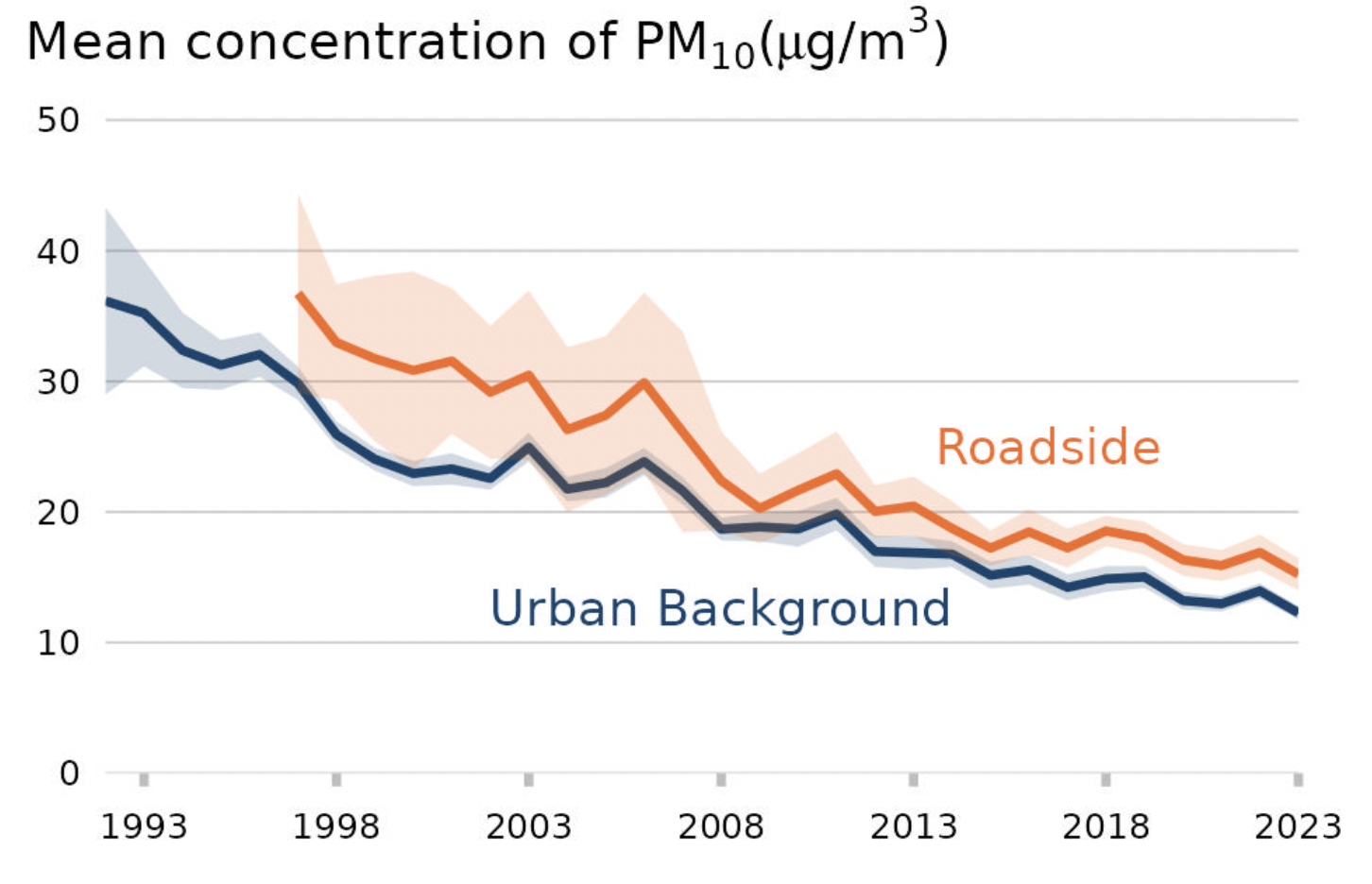The UK government has just released updated statistics on air quality for 2023, and there’s some good news to report. Particulate matter pollution, which consists of tiny particles in the air that can have serious health impacts, has reached its lowest recorded levels at both roadside and urban background monitoring sites.
Now for a little technical detail before we move on to what it all means:
- PM10, which refers to particles less than 10 micrometers in diameter, fell to an annual mean of 12.3 µg/m3 at urban background sites and 15.2 µg/m3 at roadside sites in 2023. That’s the lowest since records began in 1992 and 1997 respectively.
- Similarly, PM2.5 (particles less than 2.5 micrometers) dropped to 7.2 µg/m3 at urban background sites and 7.7 µg/m3 at roadside locations, again the lowest figures seen since nationwide monitoring started in 2009.

So what does this mean for the UK?
Well, particulate matter pollution is associated with a range of health problems, including respiratory issues, heart disease and even early death. The tiny particles can penetrate deep into the lungs and even enter the bloodstream. Children, the elderly and those with pre-existing conditions are especially vulnerable.
Lowering particulate levels means improved health outcomes and quality of life for people across the country. It’s especially important in cities and near busy roads where concentrations tend to be highest. While there’s still work to be done, it’s encouraging to see the long-term downward trend continuing.
While the 2023 statistics show encouraging declines in average pollution levels across the UK, it’s important to remember that these are annual means. Short-term spikes in PM concentrations still occur frequently, often and locally. Areas like construction sites, waste handling facilities, or delivery bays are particularly susceptible. Even temporary exposure to these elevated pollution incidents can pose serious health risks, especially for vulnerable groups.
This is where smart emissions monitoring solutions like those provided by EMSOL can make a real difference. By delivering real-time, localised insights into the root causes of pollution spikes, EMSOL’s technology empowers businesses and local authorities to take targeted action to mitigate issues as they happen.
Find out more and reach out to the EMSOL team.
Why is particulate dust pollution falling?
The report attributes the reductions to decreased emissions from various sources over time. Improved emission standards for vehicles and industry, a shift away from coal burning, and possibly even the after-effects of COVID-19 lockdowns have all likely played a role.
So while air pollution remains an ongoing concern, the 2023 statistics show that concerted efforts to clean up our air are paying off. Hopefully this progress can be sustained and built upon in the years to come, for the benefit of everyone’s health and wellbeing.
FAQ: UK Air Quality Statistics 2023 – Particulate Matter Pollution at Record Low
Q: What are the latest figures for particulate matter pollution in the UK?
A: In 2023, the annual mean concentration of PM10 fell to 12.3 µg/m3 at urban background sites and 15.2 µg/m3 at roadside sites, the lowest levels since records began. PM2.5 dropped to 7.2 µg/m3 at urban background sites and 7.7 µg/m3 at roadside locations, also the lowest figures since nationwide monitoring started in 2009.
Q: Why is reducing particulate matter pollution important?
A: Particulate matter pollution is linked to various health issues, including respiratory problems, heart disease, and premature death. The tiny particles can penetrate deep into the lungs and even enter the bloodstream. Reducing particulate levels leads to better health outcomes and quality of life, especially for vulnerable groups like children, the elderly, and those with pre-existing conditions.
Q: What are the sources of particulate matter pollution in the UK?
A: Particulate matter pollution comes from a variety of sources, including domestic wood and coal burning, industrial processes, and road transport (particularly from tire and brake wear). Some particulate matter also comes from natural sources like sea spray and pollen, or is carried to the UK from other countries.
Q: How does the UK monitor particulate matter pollution?
A: The UK measures concentrations of PM10 and PM2.5 at a network of monitoring sites across the country. These sites are located in both urban background areas (representative of typical population exposure) and near busy roads (where concentrations are often higher). The data is used to assess overall pollution levels and identify key sources.
Q: What are the UK’s targets for particulate matter pollution?
A: The UK has set both short-term and long-term targets for particulate pollution. These include annual mean concentration limits for PM10 (40 µg/m3) and PM2.5 (20 µg/m3 currently, dropping to 10 µg/m3 by 2040 in England), as well as caps on the number of days high levels can be exceeded. There are also goals to reduce overall population exposure.
Q: What has contributed to the decline in particulate matter pollution over time?
A: The long-term decrease in particulate pollution is attributed to reduced emissions from various sources. This includes improved emission standards for vehicles and industry, a shift away from coal-fired power generation, and general air quality management efforts. The COVID-19 lockdowns and associated reductions in travel and economic activity may have also contributed to recent declines.





